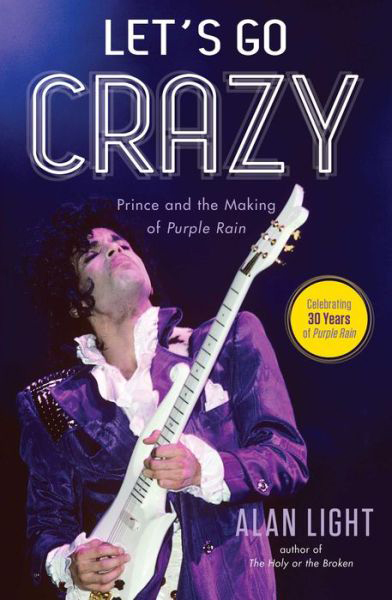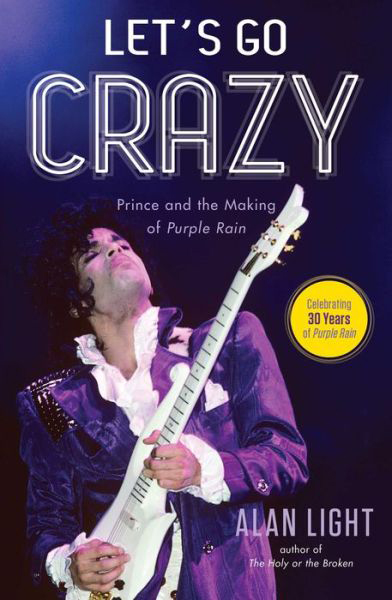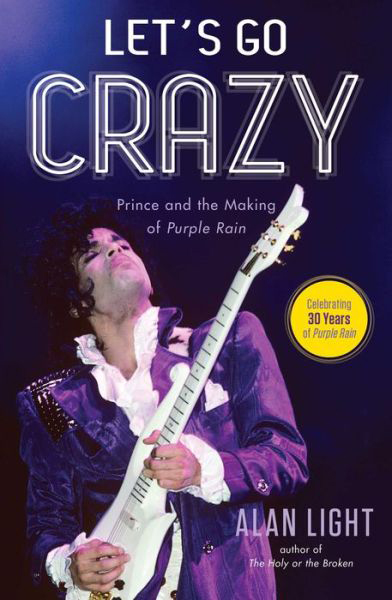Prince and the Making of _Purple Rain_ (Exclusive Book Excerpt)

Back in 2014 Relix contributor Alan Light wrote a book that explored Prince’s initial multimedia efforts. We ran an exclusive excerpt in the magazine and online, which we revisit today, following news of Prince’s tragic passing at age 57.
we feature an excerpt from the forthcoming work, which focuses on his songwriting.
Excerpt from LET’S GO CRAZY: Prince and the Making of Purple Rain by Alan Light, Copyright @2014 by Alan Light, to be published by Atria Books in December 2014, an imprint of Simon and Schuster. Reprinted with permission of author. All rights reserved.
*****
He may have handed over a huge batch of songs, but Prince didn’t stop making more music. The 1999 tour had ended on April 10, 1983; by early June, Prince had set the band up for rehearsal in a warehouse off of Highway 7 in the St. Louis Park neighborhood of Minneapolis. The building has since been torn down, leaving just an empty space, next to the electrical towers of a St. Louis Park substation, in the spot where the Purple Rain album came together.
“The whole experience at that warehouse was a really different thing,” says Lisa Coleman [who was then performing in Prince’s band The Revolution]. “It kind of stands out—it was set apart, away from other buildings. Usually, we would rehearse in these industrial parks and they were busy, we would have hours where we couldn’t play because there were businesses being run there.”
Rehearsal was as relentless as ever, maybe even more intense because they didn’t need to stop. “Prince was such a structured boss, there was no real fun in it,” says Susannah Melvoin, who became part of the Minneapolis family in addition to watching her sister work. [Wendy Melvoin appeared in Prince’s backing group and would later form Wendy & Lisa with Coleman.] “If you were five minutes late, he’d dock your pay. You might work on the same groove for five hours nonstop, some three-bar thing over and over. It was like the army.”
While [Albert] Magnoli [who would direct Purple Rain] was refining his choices for the movie, certain songs seem to have risen to the top for Prince. “Baby I’m a Star” was a carefree, straight-up boast. He had started working on the song as far back as 1981, recording a solo piano version while working on remixes for the Controversy track “Let’s Work.”
Its eventual companion piece, “I Would Die 4 U,” had a comparably breezy groove, though the lyric was something quite different. The title phrase, which would fill a dramatic moment in the Purple Rain script, was something Prince remembered his own father saying, but he transformed it from the notion of surrendering everything to love into an invocation of spiritual salvation; “I’m your messiah,” he sings, and “if you’re evil, I’ll forgive you by and by.” Dez Dickerson [guitarist for The Revolution] told Touré, for his 2013 study of Prince, that was titled after this song, that he takes the lyric at face value: “I think Prince had experienced something. I think he had a moving experience with respect to the idea of who Jesus is or was and he wanted to express it in a song. It’s not a very cloaked lyric. It says what it says. He’s saying he is Jesus.”
Questlove reads the song more metaphorically. “I think, in his mind, he was lending voice to what he perceived as being the gospel message. I don’t think he’s literally saying he’s the Messiah, but in his own way, he’s speaking for the Messiah.” Years later, after Prince became a Jehovah’s Witness, he would continue to perform the song, but would make things much clearer by changing the line “I’m your messiah” to “He’s your messiah.”
The song contributed to the theme of redemption that would run through much of Purple Rain, but it isn’t one of the set’s most musically challenging tracks. “‘I Would Die 4 U’ and ‘Baby I’m a Star’—they were fun dance tracks and he did those things easily,” says Susan Rogers, who moved to Minneapolis in the summer of 1983 to help Prince set up recording equipment in the warehouse and at his home. “Just because he does them easily doesn’t mean that they’re not great, but I would venture to guess that he didn’t put nearly as much effort into those.”
The most complex piece in this batch was one he had been working on since the 1999 tour, and would continue to refine until the last minute—well after filming had stopped. “We were jamming one day,” says [keyboard player Matt] Fink, “and I’m playing something and he goes, ‘Oh, that’s nice.’ And then that turns into ‘Computer Blue,’ which became a full-blown collaboration between Prince, me, Lisa, Wendy and Prince’s father, who wrote the main melody to the bridge section of that song.”
“We did the basic track at the warehouse,” says Rogers, “but there was quite a bit of editing with that; we brought it to Sunset Sound [in Los Angeles] and we made substantial changes on it. The basic piano part was the same, but a lot of overdubbed parts were different.” In fact, “Computer Blue” expanded (past the 14-minute mark) and contracted significantly over eight months—one instrumental section that was cut turns up in the Purple Rain movie, in a scene where Prince is late to rehearsal and Fink, Bobby Z, and Mark [Brown] are playing a jagged instrumental. A lengthy spoken-word section, known among Prince super fans as the “hallway speech,” sees Prince walking down a hallway with a girlfriend and assigning emotions (love, lust, hate) to each room. Vaguely reminiscent of Jim Morrison’s recited section in The Doors’ epic “The End,” this segment would also eventually be dropped.

The members of The Revolution weren’t entirely thrilled with the first bunch of songs for the album, or soundtrack, or whatever it was going to be. “The songs weren’t as funky to me,” says Wendy Melvoin. “They were pop songs, they were definitely watered down. It was really white and it felt that way.”
“I think that Prince felt that way, too,” adds Coleman, “because then he went and did ‘Darling Nikki’—which was not necessarily funky, but it was full-out angry energy, something that was missing. He would imitate an old granny, like, ‘You could make granny dance with this one,’ but then I think he was just like, ‘We’re leaning it too far to the granny, we still need danger.’”
Dickerson notes that a new approach was evident from the time Prince was first presenting embryonic new material during the 1999 tour. “It was clear that he wanted to write classic pop-rock hits,” he says. “The songs on 1999 had been a significant shift in being more polished and accessible, and this was the next step in that evolution. It was definitely calculated—that word gets used in a negative way, but this was through the lens of being smart, and trying to write the kind of songs that galvanized moments in a film, and vice versa.”
In addition to working on the raw, snarling “Darling Nikki,” with its lyric that would later incur the wrath of Tipper Gore and lead to the formation of the Parents Music Resource Center, he was working on a song with an even more provocative title—“Electric Intercourse.” The song itself, though, is actually not the nasty rocker the name might imply, but a more slinky and subtle R&B number, just electric piano and drums; it was part of the early track list for the album, built on the recording from the First Avenue benefit, but ultimately wasn’t deemed essential enough to make the cut. (In a May 2014 show in Birmingham, England, Prince broke out the song for the very first time since that 1983 performance; he played it solo on the piano, though in accordance with his more conservative approach as a Jehovah’s Witness, he didn’t sing the word intercourse.)
The initial motivation for “Purple Rain” came from Prince’s observation of another rock star on the road. While much has been made over the years of a rivalry between Prince and Michael Jackson, those around him say that his competitive streak reached much further than just one artist (“Michael wasn’t the biggest priority to kill—it was everybody,” says Melvoin, as Coleman adds with a laugh, “It was Prince against the world.”) He was obsessively reading music and fashion magazines, tracking anyone or anything that had some heat, sensing which lessons he might absorb.
During many dates on the 1999 tour, Prince had followed Bob Seger into the arenas of Middle America. One night, he asked Matt Fink why the proudly working-class Detroit rocker had such a huge appeal; Fink replied that it was Seger’s big, gut-punching ballads—“We’ve Got Tonight,” “Turn The Page”— that his fans loved, and that Prince should try writing that kind of anthem if he really wanted to conquer the pop world.
In December 1982, Prince showed the chords of a new ballad to the band during soundcheck at Cincinnati’s Riverfront Coliseum. “I remember him coming in and he had this idea,” says Melvoin. “He made it clear, ‘I need to find this thing, it needs to be this and it has to be this tempo,’ and then he picked a key and we started jamming and came up with that opening chord sequence and it just started to happen.” What was happening, of course, was the genesis of “Purple Rain,” even though lyrics and a title, much less any notion that it would provide the name to a movie, were still months away.
Melvoin took the chords that Prince showed the band and spread them out, added suspensions; whether the listener could follow the structure or not, the sound was something other than the obvious. “At that time, there weren’t a lot of super-pop bands, other than maybe Andy Summers [of The Police], who were doing those kinds of things, doing harmonies that advanced,” she says.
“He loved how Wendy was able to take it away from a country feel,” says Coleman, “and then everyone in the band seemed to make it a little bit different. But when I put the high harmony on the chorus, then he was like, ‘Lisa’s bringing it back around again to good old American, country music.’ ”
“The band was given the chord progression, and we ended up pretty much writing our own parts,” says Fink. “I do recall during the first time jamming on that song, I played that line on the piano that he sings at the end, when he goes up into his falsetto for that big peaking line—that came from me, just by sheer accident, and he latched onto it and sang it.
“And that coda piece on ‘Purple Rain,’ where I play that little piano riff? I have to give Lisa a lot of credit for that because she showed me this trick she had, where the left hand is doing one part and the right hand is doing this other thing against it, in counterpoint. It’s kind of a weird rhythmic thing that she knew and I said, ‘That’s really cool—show me how you do that.’ So she actually taught me how to do that part.”

With the music in place, Prince turned to a new friend for help with the lyrics. Recently, Stevie Nicks—the bewitching singer in his beloved Fleetwood Mac, who was currently working on a solo project—had called him, telling him that she had written a new song while humming along to “Little Red Corvette,” so she was going to give him a songwriting credit and also wanted to invite him to play on the session. He showed up at the Los Angeles studio an hour later, and the song, “Stand Back,” became a big hit. Nicks asked if they might write together someday, and he sent her a cassette of the ballad in progress, encouraging her to write some words.
“It was so overwhelming, that 10-minute track, that I listened to it and I just got scared,” Nicks later told the Minneapolis Star Tribune. “I called him back and said, ‘I can’t do it. I wish I could. It’s too much for me.’ I’m so glad that I didn’t, because he wrote it, and it became ‘Purple Rain.’ ”
Once the structure was completed and the lyrics were in place sometime in the summer, those around the rehearsals recall the intense power the song seemed to have over people. Melvoin and Coleman remember a homeless woman wandering into the warehouse and listening to them play “Purple Rain” for hours; when they took a break, they found her still outside, weeping.
“Big Chick [bodyguard Chick Huntsberry] came to rehearsal one afternoon,” says Alan Leeds, “and he said, ‘Buddy, you ain’t gonna believe the song the boy did last night. He wrote a new song in the studio, it’s gonna be the biggest hit of this album. Willie Nelson’s gonna cover it, you wait and see!’ It was ‘Purple Rain,’ and when I heard that, I was like, ‘That’s a hit.’” (Funk maestro George Clinton later agreed with the bodyguard’s assessment. He said, “‘Purple Rain’ always reminded me of Jimi Hendrix singing country music—take all the effects off and it’s a country-and-western song.”)
The song’s title touched on an image that Prince had long been bouncing around, and would become a defining element of his image: Thirty years later, Arsenio Hall still referred to Prince’s fans as “the Purple Army.” One of his early demos mentioned a “purple lawn,” and he had already written songs titled “Purple Music” and “Purple Shades.” His father said that purple was always Prince’s favorite color. The breakthrough hit of an earlier generation’s African- American guitar hero, Jimi Hendrix, was titled “Purple Haze,” and on “1999,” Prince began his description of the impending apocalypse with the phrase “the sky was all purple”—and, of course, there was the series of signature purple trench coats that he had been wearing on album covers and in music videos.
As Touré points out in his book, in the King James translation of the Bible, immediately prior to the crucifixion, Jesus is prepared in the following ways: “And they clothed him with purple, and platted a crown of thorns and put it about his head and began to salute him.” In 1984, Wendy Melvoin summarized the song title simply and plainly. “A new beginning—purple, the sky at dawn; rain, the cleansing factor.”



















